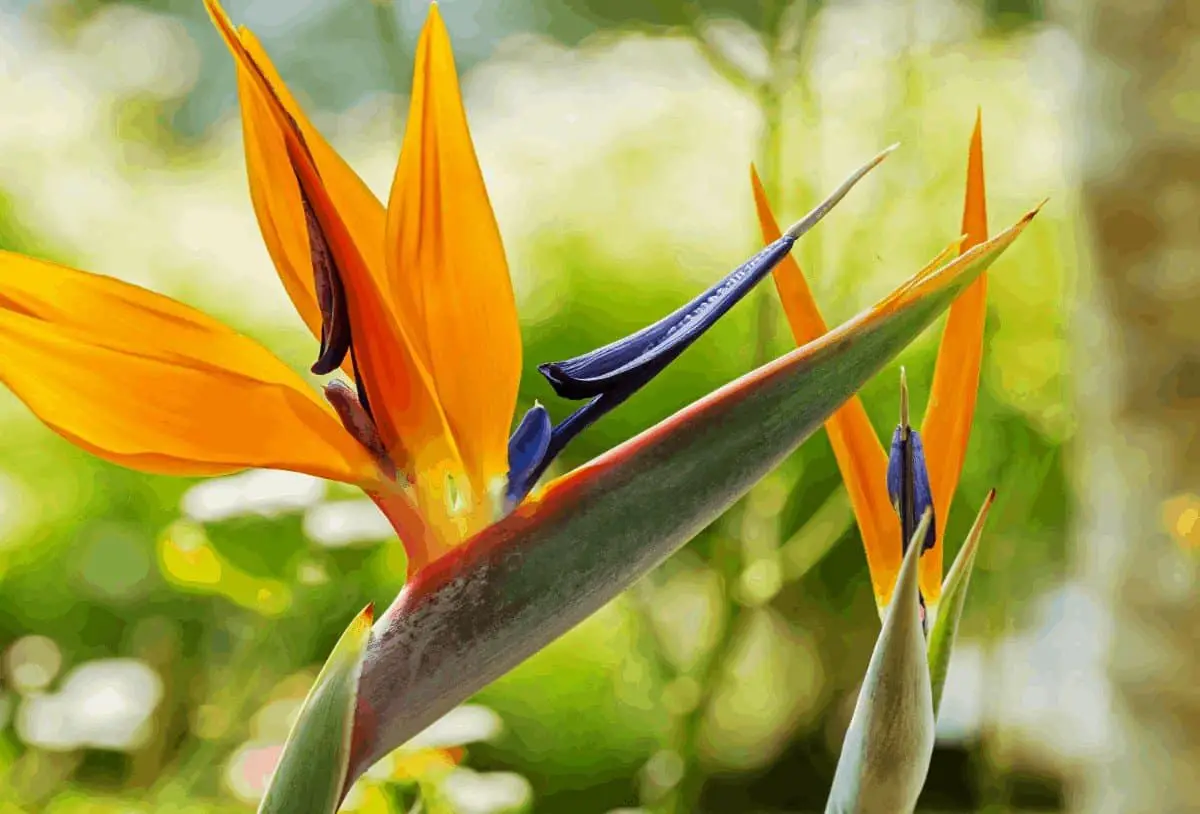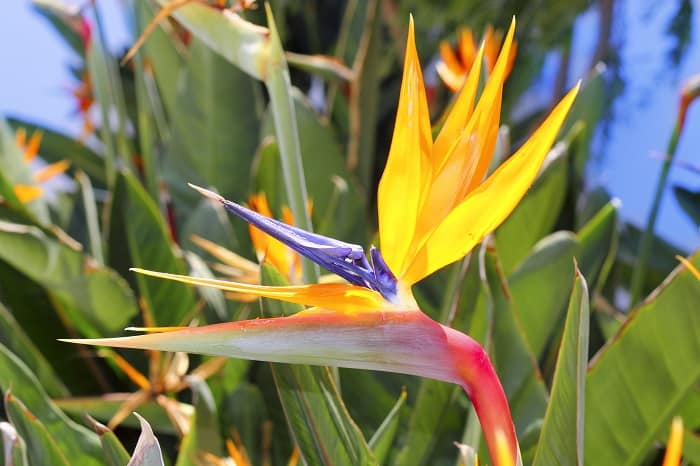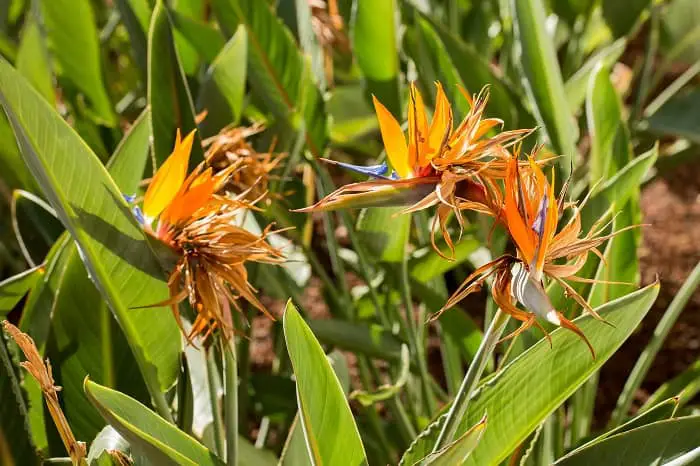Last Updated on January 6, 2022 by
The bird of paradise is a popular plant in warmer tropical zones that can supply the right environment for the large, glossy leaves and unique blooms. One of the best areas for the plant is in Southern California, where it seems ubiquitous along sidewalks and promenades. Bird of paradise leaves curling is a common issue for amateur and experienced gardeners alike. However, gardeners have never been satisfied with only growing flowers that suit their region. And many have tried to recreate the necessary climate to keep a bird of paradise happy and healthy.
But what are you supposed to do when the leaves start curling and the petals lose their luster? If you possess one of these flowers and are concerned about its health, follow this guide. It will help you identify the source of the problem and ensure your bird of paradise remains healthy.
Bird Of Paradise Leaves Curling: What Should It Look Like?
People often enjoy the bird of paradise because of its exotic appearance. Also called the crane flower, the bird of paradise is distinct because of its long, spiked leaves and orange and blue flowers. These blooms should resemble a blue beak with an orange crest, similar to a crane. The leaves should be straight and healthy, with a dusty green hue. If your plant leaves have started curling or browning along the edges, it can be a sign of simple environmental issues or drastic problems. When trying to find an answer, it’s important to find the cause of the curling.
Bird of Paradise Leaves Curling: Identifying the Source of the Problem
If you don’t identify the source of the problem, then you have little to no chance of returning your bird of paradise plant back to health. Consider all factors, including the possibility of pests or the simple explanation of a poor environment. Make gradual changes and check on the health of the plant each day to see if it improves.
Pests and Disease
Bird of paradise plants are susceptible to numerous pests and diseases. If the leaves are curling, it could be a sign of an invasion by mites. Perhaps the most common is the spider mite, which will weave weblike structures between the leaves and petals. The easiest way to eliminate mites is to wipe down the leaves and stems with a damp cloth. You can also invest in safe pesticides if the problem seems severe.
Mites are the most likely pest, but another one is thrips. If you have thrips, wash the leaves with insecticidal soap. These bugs are difficult to see because they are only as wide as a sewing needle, so be diligent with care. The only other potential pest is scales, which can be removed with rubbing alcohol.
While bird of paradise plants can get fungi, these will not cause the leaves to curl.
Bird of Paradise Leaves Curling: Wrong Location
Because the bird of paradise plant is meant for tropical climates, it can suffer when brought to the wrong plant hardiness zone. This flower is best suited to USDA plant hardiness zones 10 and 11, and it will struggle in anything colder. In other words, gardeners need to recreate that tropical/sub-tropical climate. For many, this means ensuring the plant receives full sunlight as much as possible, does not experience temperature drops below 70 degrees Fahrenheit, and receives adequate moisture.
If you are trying to grow one of these plants in any other outdoor environment, it will not last long. If the leaves keep curling and you live in a cooler, shadier region, then it might be time to move your bird of paradise indoors. Failing to do so often results in plant death once the weather turns colder.
Poor Soil Quality
The bird of paradise is surprisingly tolerant of a broad range of soil types. To have it struggling based on the soil is a rare issue, but more common when the plant has been planted. As a tropical flower, the bird of paradise prefers nutrient-rich, well-draining soil in an area or container that allows for adequate root growth. This plant has large, fleshy roots that can easily overgrow in a small container and become trapped, preventing drainage and adequate nutrition uptake.
If your leaves are curling, first make sure the bird of paradise has enough room to grow underground. If the roots are running into the sides of a pot or becoming entangled in obstacles, then it’s time to transplant. If there is adequate room for the roots, then make sure you have the right type of soil. Sometimes leave curling can be the result of poor nutrition. Try adding plenty of decomposing organic matter around the roots and base to see if the problem clears up. If it doesn’t, switch to a soil that allows for more drainage.
Not Enough or Too Much Water
Finally, make sure you giving the bird of paradise enough water! Many gardeners underestimate just how much moisture these tropical flowers require. Ensure the soil around the flower is always damp during the spring and summer. If it is winter, allow the first two inches to dry before supplying more water. The bird of paradise does not like having wet feet, which means the roots should not be left to sit in soggy soil. If water remaining in the soil or pot proves to be a consistent problem, then it is likely time to transplant or perform a complete overhaul of the soil itself.
Finally, the bird of paradise is used to humidity. If the leaves seem dry but the soil is still damp, consider doing a light misting to give the leaves extra moisture without compromising the roots.
Conclusion
It is remarkably common to experience leaves curling on a bird of paradise plant. While these flowers are quite hardy, they still need to have their needs met. Ensure you are supplying adequate sunlight, moisture, and soil quality. If you are and the plant is still suffering, then check for pests and diseases. These are the most common reasons why you now have a sad bird of paradise.
FAQ’s
Do birds of paradise like coffee grounds?
When it comes to feeding and fertilizing birds of paradise, it will thrive if you give it good quality granular fertilizer if it’s outdoors. If planted indoors, a good tropical plant fertilizer will do it justice.
Using coffee grounds is not advised. But if you choose to use them, do so sparingly for either indoor or outdoor plants. Coffee grounds damage the plant in multiple ways that include:
- Coffee contains anti-bacterial agents that kill the beneficial microbes in the soil. This leads to the loss of nutrients and nitrogen.
- Coffee has caffeine that suppresses plant growth
- Ground coffee is not good mulch it restricts air and water from penetrating the soil
What month does the bird of paradise bloom?
Successful birds of paradise start to bloom at the end of September, beginning of October. In these months, you will see the first buds appear. And by mid-December, you will have your first bloom all beautiful.
The key to this success is allowing your plant a lot of sunlight during summer. Do not water it too often; birds of paradise thrives in some neglect. When it is a bit stressed it is likely to bloom unlike when you give it too much attention. Remember, don’t neglect it too much or at the wrong time. Neglect it a bit when it’s ready to bloom.
If growing indoors, take your plants outside or place them near a window that gives direct sunlight. The more sun they get the better!
How can I make my bird of paradise grow faster?
Birds of paradise grow fast in well-drained, moist soils. If you keep the soil well watered in summer and spring but allow it to dry a little in winter, it will thrive.
This plant hates soggy soils or soils that dry out too fast. Overwatering causes root rot making the plant die.
Fertilize the plant every month until fall with a balanced organic fertilizer like 5-5-5. Do not grow it too crowded or it will not flower.
What is the best fertilizer for the bird of paradise?
The best fertilizer for birds of paradise is organic fertilizer. This fertilizer includes compost manure, blood meal, or sewage sludge. Fertilizer granules can also work. Spread it around the plant every 3 months during the growing season.
This plant is a heavy feeder and needs fertilizer every two weeks. Fertilize it throughout the summer season and monthly during winter.
Over-fertilization leads to more foliage growth with little or no flowering. To be sure you are doing it right, get the right fertilizer and follow the right frequency of application for the best results.
Can birds of paradise grow indoors?
Yes, it is possible to grow birds of paradise plants indoors. You can grow these tropical beauties indoors as a houseplant. Give the plant enough sunlight and the right conditions and it will thrive. The plant will produce a vibrant display of flowers creating an atmosphere of tropical bliss in the interior of your home.
FAQs
What does it mean when my bird of paradise leaves curl?
The bird of paradise is a plant that often symbolizes the end of a relationship. The curls can be interpreted as hair, and when your bird of paradise starts to curl up it could be a sign that the relationship is over and that your partner is starting to move on.
Nature has always been our best friend in times of need. This goes even more for times when we're trying to figure out what's going on in our love life or relationships. When we see flowers starting to curl up, it means they are dying and wilting away.
When a bird of paradise (Strelitzia reginae) starts to curl it leaves on its own this can be happening when their water source dries out or if the plant is not cared for properly. The curling of leaves on the plant may be an indication of over watering or too much sun exposure.
How do I stop my leaves from curling?
There are a few key things you can try to keep your leaves from curling. The first is to make sure they are getting enough water.
The second is to make sure that the soil in your pot is moist, but not wet. If the soil is too wet, it will take a lot of time for the water to drain out and this will cause the roots of your plant to rot away.
Another way to stop the leaves from curling is by adding a small amount of cooking oil to the water.
The final way is to place an insect screen over your potted plant. This will allow air circulation but keeps bugs out.
How do I know if my bird of paradise is dying?
The first step to know if your bird of paradise is dying is to know what kind of bird of paradise it is. There are three types of birds-of-paradise: the red, the blue and the black-and-white.
If you have a red bird, the leaves will turn brown and dry up. If you have a blue bird, it will turn yellow and fall off. If you have a black-andwhite bird, it will droop downward.
A sign that your plant is not getting enough sun is that the leaves have brown edges or spots on them from lack of sunlight.—
Will bird of paradise leaves uncurl?
The leaves are covered with tiny hairs that adhere to one another and these hairs form a layer of cells that work as a kind of adhesive.
The leaves of the bird of paradise remain tightly curled for many months. This is because they are designed to repel water to prevent them from wilting. The leaves uncurl once they are dry, which can take up to a year.
However, generally speaking the answer is no. Bird of paradise leaves remain curled because the plant needs to make use of every bit of water and sunlight that it can.
Tony Manhart is a passionate gardener who has been tending to gardens for over 20 years. He takes pride in creating beautiful outdoor spaces with plants, trees, and shrubs that can thrive in any environment. He loves to share his knowledge with others and has taught classes on gardening basics and advanced techniques. He is committed to sustainability, using natural and organic methods to create and maintain gardens. He also works with local organizations to create green spaces for communities. When he’s not gardening, Tony enjoys hiking, reading, and spending time with his family.




